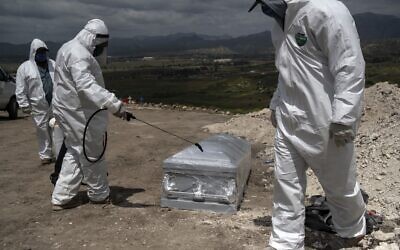Some countries list only those who die in hospitals, others include victims suspected of carrying the virus who were never tested
By JEAN-PHILIPPE CHOGNOT, ISRAEL HAYOM 28 April 2020,

Aerial view of cemetery workers unloading a coffin from a truck at an area where new graves have been dug at the Parque Taruma cemetery, during the COVID-19 coronavirus pandemic in Manaus, Amazonas state, Brazil, on April 21, 2020. (MICHAEL DANTAS / AFP)
PARIS, France (AFP) — The daily count of fatalities of the COVID-19 pandemic, whose official toll has now passed 210,000, is a sensitive business, with data often incomplete and differing methods between countries.
Germany, Luxembourg, South Korea and Spain count all deaths of those who have tested positive for COVID-19, whether they take place in hospital or elsewhere.
In Belgium, where care homes have officially accounted for more than half the deaths, the figures include even people who have not been tested, but are suspected of having been infected.
France also counts deaths in care homes, which make up more than a third of the number.
Other countries, such as China and Iran, only count deaths in hospitals in their daily tolls.

Omar Rodriguez organizes bodies in the Gerard Neufeld funeral home on April 22, 2020 in the Elmhurst neighborhood of the Queens borough in New York City. (Spencer Platt/Getty Images/AFP)
That is also the case in Britain. More complete figures are published every week by the Office for National Statistics, but with a time lag of 10 days, and these figures do not include deaths in Scotland and Northern Ireland.
In Italy, which has Europe’s highest official death toll, only the biggest retirement home hotspots are accounted for, according to the Civil Protection.
In the United States, which has the highest death toll in the world at more than 50,000, the counting method varies from one state to another: while New York counts deaths in care homes, California does not.
Some countries, such as Belgium, Britain, Italy, Luxembourg, South Korea and Spain include in their figures all the people who have tested positive for the coronavirus, even those who died of complications from a pre-existing condition. Other countries are more selective.

Cemetery workers wearing protective gear prepare to bury an unclaimed COVID-19 coronavirus victim, at the Municipal cemetery No. 13 in Tijuana, Baja California state, Mexico, on April 21, 2020. (Guillermo Arias / AFP)
Iran excludes from its toll patients who have tested positive but die of another serious respiratory illness.
In the United States, there are an increasing number of complaints from people whose relatives have died, officially of pneumonia, before COVID-19 tests became available.
In Germany, no distinction is made in the statistics between those who died directly from COVID-19 and those who could have died of a pre-existing condition, or the two combined.
That lack of differentiation has been a bone of contention between the national institute which oversees epidemics and some of the country’s regions which presented lower death tolls because they carried out autopsies in order to determine the precise cause of death.
During an epidemic, it takes time to gather and process information, even if attempts are made to speed things up, according to Gilles Pison and France Mesle, experts from the French Institute for Demographic Studies (INED), in early April.
“You need several weeks or several months to be able to precisely count all the deaths,” they said.

Ray Neufeld pauses while organizing bodies in the Gerard Neufeld funeral home on April 22, 2020 in the Elmhurst neighborhood of the Queens borough in New York City. (Spencer Platt/Getty Images/AFP)
In the United States, even if there has been no test carried out, death certificates must mention whether COVID-19 is the “probable” cause of death. But these certificates take time to mount up and cannot be taken into account for real time death tolls.
Due to a lack of tests, Spain carries out very little post-mortem screening. So if a person was not screened before dying, he is not counted by the health authorities.
Data collected by the judicial authorities is less restrictive and reveals a much higher toll: legal authorities in the Spanish region of Castilla La Mancha, for example, recorded in March three times more deaths “due to COVID or suspected COVID” than those recorded by the health authorities.
In Bergamo in Italy’s coronavirus epicenter Lombardy, in the first half of March 108 more deaths were recorded compared to the same period last year. That is an increase of 193 percent, but only 31 deaths were linked to the coronavirus.

In this March 26, 2020, photo, a member of the Iranian army walks past rows of beds at a temporary 2,000-bed hospital for coronavirus patients set up by the army at the international exhibition center in northern Tehran, Iran (AP Photo/Ebrahim Noroozi)
Some countries have been accused of lying about their death statistics.
In Iran, the official figures have been disputed, particularly at the start of the epidemic, by officials in the provinces and parliamentarians. Washington has in particular accused Tehran of covering up its real figures.
China, where the epidemic started in December, has been criticized by several world leaders for its management of the crisis. On April 17 it revised upwards by nearly 40 percent its toll.
The central city of Wuhan, where the virus first emerged, counted an extra 1,300 fatalities, saying that some had not been included because they had died at home.



Politicization of the Wuhan virus!